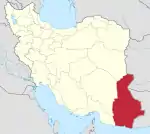Sistan and Baluchestan Province
Sistan and Baluchestan Province (Persian: استان سيستان و بلوچستان, romanized: Ostân-e Sîstân vä Bälűčıstân; Balochi: سیستان و بلوچستان, romanized: Sistân o Balučestân) is the second largest province of the 31 provinces of Iran, after Kerman Province. It is in the southeast of the country, bordering Pakistan and Afghanistan and its capital is Zahedan.
Sistan and Baluchestan
استان سیستان و بلوچستان | |
|---|---|
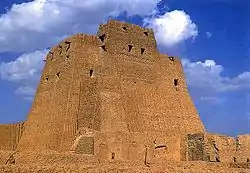 Ghal'eh Sab, Saravan. | |
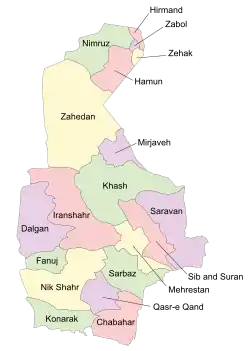 Sistan and Baluchestan Province and its counties | |
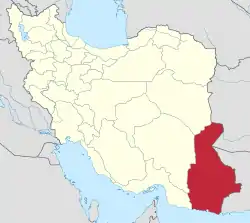 Map of Iran with Sistan and Baluchestan highlighted | |
| Coordinates: 29.4924°N 60.8669°E | |
| Country | |
| Capital | Zahedan |
| Counties | 19 |
| Area | |
| • Total | 180,726 km2 (69,779 sq mi) |
| Population (2016)[1] | |
| • Total | 2,775,014 |
| • Density | 15/km2 (40/sq mi) |
| Time zone | UTC+03:30 (IRST) |
| • Summer (DST) | UTC+04:30 (IRST) |
| Main language(s) | Baluchi Persian (Sistani dialect) |
| HDI (2017) | 0.688[2] medium · 31st |
The province is the second largest province in Iran with an area of 180,726 km2 and a population of 2.5 million.[3] The counties of the province are Chabahar County, Qasr-e Qand County, Dalgan County, Hirmand County, Iranshahr County, Khash County, Konarak County, Nik Shahr County, Saravan County, Sarbaz County, Sib and Suran County, Zabol County, Mehrestan County, Zahedan County, Zehak County, Hamun County, Nimruz County, Bampur County, Mirjaveh County and Fanuj County.
The population comprises the Baloch who form a majority in the province, followed by the relatively large minority, the Sistani Persians. Smaller communities of Kurds (in the eastern highlands and near Iranshahr), the expatriate Brahui (on the borders between Iran and Pakistan), and other resident and itinerant ethnic groups such as the Romani are also found in the province.
Geography and culture
The province comprises two sections, Sistan in the north and Baluchestan in the south. The combined Sistan and Baluchestan province today accounts for one of the driest regions of Iran with a slight increase in rainfall from east to west, and an obvious rise in humidity in the coastal regions. The province is subject to seasonal winds from different directions, the most important of which are the 120-day wind of Sistan known as Levar, the Qousse wind, the seventh (Gav-kosh) wind, the Nambi or south wind, the Hooshak wind, the humid and seasonal winds of the Indian Ocean, the North or (Gurich) wind and the western (Gard) wind. The province borders South Khorasan Province in the north, Kerman Province and Hormozgan Province in the west, the Gulf of Oman in the south, and Afghanistan and Pakistan in east.
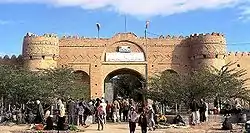
In the south, east and west of Sistān and Balūchestān, the people are mostly Balōch and speak the Baluchi language, although there also exists among them a small community of speakers of the Indo-Aryan language Jadgali.[4]:25 In the far north of Sistān and Balūchestān, the people are mostly Persians and speak a dialect of the Persian language known as Sistani/Seestani, similar to the Dari Persian language in Afghanistan. The name Balūchestān means "Land of the Balōch" and is used to represent the majority Baloch peoples inhabiting the province, Sistan was added to the name to represent the minority Persian peoples who speak the Sistani dialect of Persian.
Many scholars, orators, and literary personalities have sprung up from this part of Iran, amongst which are Farrukhi Sistani, Ya'qub bin Laith as-Saffar and Rostam. Ayatollah Sistani is also from Sistān; though he currently resides in Najaf, Iraq .
Religion
The Sistani people of "Sistan and Baluchestan province" are Shia Muslims, and the people of Baluchestan area are Sunni Muslims.[5]
History
In the epigraphs of Bistoon and Persepolis, Sistan is mentioned as one of the eastern territories of Darius the Great. The name Sistan, as mentioned above, is derived from Saka (also sometimes Saga, or Sagastan), a Central Asian tribe that had taken control over this area in the year 128 BC. During the Arsacid Dynasty (248 BC to 224 AD), the province became the seat of Suren-Pahlav Clan. From the Sassanid period till the early Islamic period, Sistan flourished considerably.
During the reign of Ardashir I of Persia, Sistan came under the jurisdiction of the Sassanids, and in 644 AD, the Arab Muslims gained control as the Persian empire was in its final moments of collapsing.
During the reign of the second Sunni caliph, Omar ibn Al-Khattab, this territory was conquered by the Arabs and an Arab commander was assigned as governor. The famous Persian ruler Ya'qub-i Laith Saffari, whose descendants dominated this area for many centuries, later became governor of this province. In 916 AD, Baluchestan was ruled by the Daylamids and thereafter the Seljuqids, when it became a part of Kerman. Dynasties such as the Saffarids, Samanids, Qaznavids, and Seljuqids, also ruled over this territory.
In 1508 AD, Shah Ismail I of the Safavid dynasty conquered Sistan, and during the reign of Nader Shah, there was further turmoil.
Sistan and Baluchestan today


Sistan and Baluchestan is the poorest of Iran's 31 provinces, with a HDI score of 0.688.[2]
The government of Iran has been implementing new plans such as creating the Chabahar Free Trade-Industrial Zone.
Colleges and universities
- University of Sistan and Baluchestan
- Chabahar Maritime University
- Zabol University
- Islamic Azad University of Iranshahr
- Islamic Azad University of Zahedan
- Zahedan University of Medical Sciences
- Zabol University of Medical Sciences
- International University of Chabahar
- Velayat University of Iranshar
- Jamiah Darul Uloom Zahedan
Transportation
National rail network
The city of Zahedan has been connected to Quetta in Pakistan for a century with a broad gauge railway. It has weekly trains for Kovaitah. Recently a railway from Bam, Iran to Zahedan has been inaugurated. There may be plans to build railway lines from Zahedan to Chabahar.[6]
Airports
Sistan va Baluchistan Province has two main passenger airports:
- Zahedan Airport
- Chabahar Airport (Konarak Airport)
Industry and mining
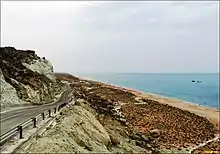

Industry is new to the province. Efforts have been done and tax, customs and financial motivations have caused more industrial investment, new projects, new producing jobs and improvement of industry.
The most important factories are: – Khash cement factory with production of 2600 tons cement daily and three other cement.
Factories under construction: – Cotton cloth and fishing net weaving factories and the brick factory can be named as well.
The province has important geological and metal mineral potentials such as chrome, copper, granite, antimony, talc, manganese, iron, lead, zinc, tin, nickel, platinum, gold and silver.
One of the main mines in this province is Chel Kooreh copper mine in 120 km north of Zahedan.
See also

References
- "Archived copy" (PDF). Archived from the original (PDF) on 15 March 2017. Retrieved 19 March 2017.CS1 maint: archived copy as title (link)
- "Sub-national HDI - Area Database - Global Data Lab". hdi.globaldatalab.org. Retrieved 13 September 2018.
- Selected Findings of National Population and Housing Census, 2011
- Delforooz, Behrooz Barjasteh (2008). "A sociolinguistic survey of among the Jagdal in Iranian Balochistan". In Jahani, Carina; Korn, Agnes; Titus, Paul Brian (eds.). The Baloch and others: linguistic, historical and socio-political perspectives on pluralism in Balochistan. Wiesbaden: Reichert Verlag. pp. 23–44. ISBN 978-3-89500-591-6.
- Sistan and Baluchestan Province tabnak.ir Retrieved 20 July 2020
- http://www.investiniran.ir/OIETA_content///fa/pprojects/chabahar.pdf
- "From Gwadar to Chabahar, the Makran Coast Is Becoming an Arena for Rivalry Between Powers". The Wire.
Bibliography
- W. Barthold (1984). "Sistan, the Southern Part of Afghanistan, and Baluchistan". An Historical Geography of Iran. Translated by Svat Soucek. Princeton University Press. pp. 64–86. ISBN 978-1-4008-5322-9.
External links
| Wikisource has the text of the 1911 Encyclopædia Britannica article Baluchistan (Persia). |
| Wikimedia Commons has media related to Sistan and Baluchestan Province. |

